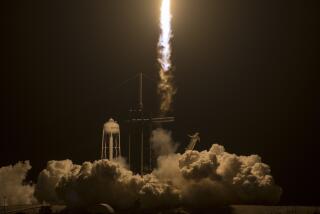Tiny Satellite Saves Itself From Being Lost in Space
- Share via
If robotic spacecraft were as human as they sometimes seem, this one would probably be known as the little guy that just wouldn’t give up.
Unmanned satellites frequently diagnose their own maladies, make adjustments needed to survive and allow themselves to be reprogrammed in orbit, but the 240-pound ALEXIS has set a tough new standard. The $17-million satellite was launched into orbit April 25 aboard an Air Force Pegasus rocket but failed to respond to commands from the ground.
Designed to test advanced instruments that could help detect weapons proliferation around the world, ALEXIS is the brainchild of scientists at the Los Alamos National Laboratory. Officials at the New Mexico lab had hoped that their first home-grown satellite would prove that they could handle space missions faster, better and cheaper than the National Aeronautics and Space Administration, which has had its own problems of late.
But ALEXIS, which stands for Array of Low-Energy X-ray Imaging Sensors, was damaged during the launch.
“There are a lot of sad faces around here right now,” Bill Priedhorsky, leader of the ALEXIS team, said the day after the launch. Engineers determined that one of the four solar panels aboard the craft had failed to open. The damaged panel was to provide power to an instrument crucial to orienting the spacecraft. Without it, the solar panels that supply electricity to run the satellite’s critical systems might not be able to aim toward the sun and collect enough energy to do the job.
The story might have ended there, but unknown to ground controllers the small satellite was busily trying to orient itself so that the three remaining solar panels could pick up enough energy for the craft to correct its own deficiencies.
“Day after day, folks sent radio signals and listened for a response,” said John Gustafson, a spokesman for the lab. But nothing happened. Then, on June 2, nearly six weeks after it had been launched, the satellite suddenly “peeped.”
“Look at that!” a stunned scientist exclaimed as he gazed at the computer screen that had recorded the faint signal.
For one uneventful day after another they watched the screen, and finally the satellite peeped again, sending back information about its condition like a patient seeking the aid of a surgeon. Ground controllers used that information to send corrective messages to the satellite, and then they waited. And waited.
Nearly a month later, the satellite again responded to commands, but this time it wasn’t just a peep. Contact lasted about five minutes, a lifetime for some of the scientists who had invested years in the project, and it was long enough for controllers to shut down non-essential systems and allow the craft to use its scarce resources to heal itself.
Finally, on July 5, ALEXIS was brought under control. The satellite’s internal systems were working well, and it could get along reasonably well on three solar panels.
A week later, the satellite carried out its first experiment successfully. It had circled Earth in silence 1,119 times.
Scientists at the lab now expect to get much of the data they seek. The craft uses six telescopes to capture X-rays that could reveal evidence of weapons proliferation, and it carries an experiment designed to determine how Earth’s atmosphere distorts radio signals.
More to Read
Sign up for Essential California
The most important California stories and recommendations in your inbox every morning.
You may occasionally receive promotional content from the Los Angeles Times.










